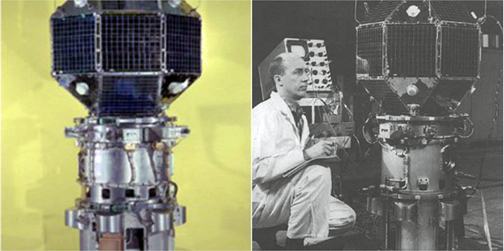
Archived photos of the LES1 satellite.
The online site Vintage News is offering a story wherein an American satellite that was abandoned in 1967 and was assumed to be space junk has, after 46 years, started transmitting once again.
This was one of the satellites designed and built by Lincoln Laboratory at MIT between 1965 and 1976 for testing satellite communication techniques. This series of satellites was easy to recognize as they were named LES1 through to LES9. LES1 to LES4 encountered various launch issues, while LES1 and LES2 were supposed to be delivered to the same 2,800 x 15,000 km orbit; however, a failure of a booster stage stranded LES1 in a 2,800 km circular orbit.
LES3- to LES4 were supposed to deploy into a geostationary orbit, but the satellites failed to do so, due to a launch problem which left them in transfer orbit. Even though the first four satellites in the series ended up in the incorrect orbits, they all produced viable results. LES 5, 6, 8acquired their correct orbits. LES7 never journeyed to space, due to the funding drying up and the program being canceled.
In 2013 in North Cornwall, UK, Phil Williams, an Amateur Radio Astronomer who refers to his hobby as "Radio Archeology," retrieved a signal which he determined to be the LES1, built by MIT in 1965. The satellite never acquired the intended orbit and had been spinning out of control ever since. Williams picked out the odd signal which was transmitting due to the craft tumbling end over end every four seconds as the solar panels were shadowed by the engine. Williams said that this action gives the signal a particularly ghostly sound as the voltage from the solar panels fluctuates.
LES1 was launched from Cape Canaveral on February 11th, 1965, but only a few of the mission's objectives were accomplished. Miswiring of the satellite circuitry caused the satellite to cease transmitting in 1967. LES2, the twin of LES1, did much better; that satellite's final orbit occurred on May 6, 1965.
More than likely, the satellite's onboard batteries disintegrated long ago and something else caused LES1's 237 Mhz transmission to resume when in sunlight. The LES1 is about the size of a small automobile. This "encounter" certainly proves that electronics built around 50 years ago—12 years before Voyager 1—and far before microprocessors and integrated circuits—are still capable of working in the hostile environs of space.
LES1 and LES2 were almost identical experimental communication satellites with a single X-band transponder and an 8 horn, electronically switched antenna. Altitude control and sensing experiments were conducted on these twin satellites. Their first project initiative was to build, launch, and field a system to show off practical military satellite communications. Project West Ford’s availability for the advanced super-high-frequency (SHF) technology (at seven-to-eight gigahertz) contributed to the decision to design the system for that band.
The concurrent procurement of a series of satellites and terminals for the Department of Defense (DoD) that commenced with the Initial Defense Communications Satellite Program (IDCSP) meant that the lessons learned from these experiments would be applicable to additional applications.

This article was sourced, and is courtesy of, Vintage News.

